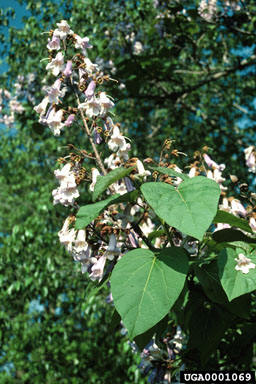
Plant: Princess Tree or Royal Paulownia (Paulownia tomentosa) is a deciduous tree that is native to East Asia: synonym – Royal Empress tree.
Identification: The Princess tree grows to 60 feet tall and 2 feet in diameter. Leaves are large and heart-shaped with opposite growth pattern and fuzzy hair on both sides. Twigs and branches are stout, glossy gray-brown and speckled with numerous white dots. There are no terminal buds but lateral leaf scars are raised and circular becoming larger, dark and sunken. The bark is light to dark gray, from roughened to becoming slightly fissured while the wood is white. Flowers, fragrant and showy pale-violet, appear from April to May. Terminal clusters of pecan-shaped pale green capsules, 1 to 2 inches long appear in the summer becoming tan by winter. By late winter, capsules turn black, splitting to release 1,000s of tiny winged seeds.
Ecology: The Princess tree, once widely planted as an ornamental around homes and infrequently planted in plantations, has escaped infestations along roadsides, riparian areas, and forest margins. It will invade an area after fire, harvesting, and other disturbances. It can spread by seed from wind and water and also colonize by root sprouts.
Herbicide Control: For large trees, hack several times on the main stem and spray cuts using 42+% active ingredient of imazapyr (Arsenal AC, Vanquish, or Polaris AC) or a 41% active ingredient of glyphosate (Accord, Razor, or Roundup) in dilutions anytime except March and April. Follow specifications on the herbicide label pertaining to cut spacing and percent solution. The same herbicides can be used on cut stems and stumps. For saplings, apply 60+% active ingredient of triclopyr (Garlon 4, Remedy, or Tahoe 4E) as a 20% solution (2.5 quarts per 3-gal. mix) in water with a surfactant (basal oil, crop oil, or methylated seed oil) at a 1% solution (4 ounces per 3-gal. mix) to young bark as a basal spray. Also, 13.6% active ingredient of triclopyr (Pathfinder II) at a 100% solution can be applied as a basal spray. For re-sprouts and seedlings, apply 42+% active ingredient of imazapyr as a 1% solution (4 ounces per 3-gal. mix) in water with a surfactant at a 1% solution. For safety to surrounding vegetation, a 41% active ingredient of glyphosate, or a 44.4% active ingredient of triclopyr (Garlon 3A or Tahoe 3A) or a 60+% active ingredient of triclopyr as a 2% solution (8 ounces per 3-gal. mix) in water with a surfactant at a 1% solution can be sprayed to thoroughly wet foliage anytime from July to October.
Warning: Imazapyr can damage plants with roots in the treated area. Always read and follow label instructions carefully.
Source: (A Field Guide for the Identification of, A Management Guide for) Invasive Plants in Southern Forests, James H. Miller, USDA Forest Service, 2010. Photo Credit: James R. Allison, Georgia Department of Natural Resources, ForestryImages.Org
Additional Resources